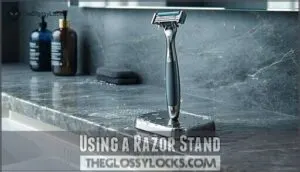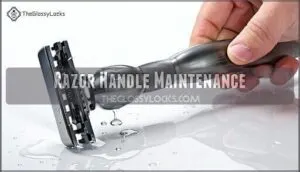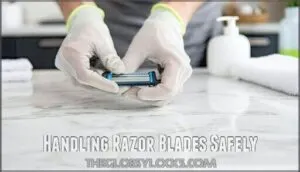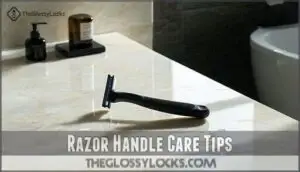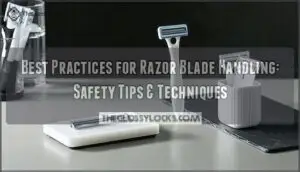This site is supported by our readers. We may earn a commission, at no cost to you, if you purchase through links.

After each use, you’ll want to rinse thoroughly and pat dry with a clean towel.
Store your razor in a cool, dry place using a stand to promote air circulation.
Weekly deep cleaning with rubbing alcohol keeps things sanitized, while monthly inspections help you spot wear before it becomes a problem.
Don’t forget to replace blades regularly and lubricate any moving parts with a drop of oil, treating your razor like a trusty tool – treat it right, and it’ll serve you well for years.
Table Of Contents
- Key Takeaways
- Razor Handle Cleaning
- Storing Razor Handles
- Razor Handle Maintenance
- Handling Razor Blades Safely
- Razor Handle Care Tips
- Razor Longevity Techniques
- Frequently Asked Questions (FAQs)
- How to clean razor blades properly?
- Do razor blades come with a refill?
- Why should you clean your razor blades?
- How can I prolong the life of my razor?
- What should I not do if my razor won’t work?
- How do you shave with a razor blade?
- How do I clean my razor handle?
- How to prevent bacteria on razors?
- How to maintain disposable razors?
- Can different razor handle materials affect grip?
- Conclusion
Key Takeaways
- Clean daily with warm water and rubbing alcohol – You’ll prevent bacterial buildup and maintain hygiene by rinsing thoroughly after each use and wiping down with alcohol-soaked cotton pads.
- Store upright in a cool, dry place using a razor stand – You’ll extend your razor’s lifespan by promoting air circulation and preventing moisture damage that leads to rust and bacterial growth.
- Inspect monthly and lubricate moving parts – You’ll catch wear early and keep pivot points functioning smoothly by checking for cracks, loose connections, and applying light oil to hinges.
- Replace blades every 5-8 shaves and don’t share razors – You’ll maintain optimal performance and prevent infections by using fresh, sharp blades and keeping your razor personal to avoid cross-contamination.
Razor Handle Cleaning
Your razor handle needs regular cleaning to stay hygienic and perform its best.
Clean it with warm water and rubbing alcohol after each use to prevent bacterial buildup and guarantee a safe, comfortable shave every time.
Daily Cleaning Routine
Establishing consistency becomes your secret weapon in razor handle care. Daily sanitizing prevents bacteria from turning your morning routine into a hygiene nightmare.
Regular razor maintenance involves understanding the importance of proper sanitization methods to guarantee a safe and healthy shaving experience.
- Rinse Techniques: Use warm water after each shave to flush away debris
- Soap Removal: Scrub gently with mild soap weekly to eliminate buildup
- Handle Wipe: Pat dry immediately to prevent moisture damage
- Morning Routine: Quick alcohol sanitizing keeps handles bacteria-free
Using Warm Water and Rubbing Alcohol
Most professionals recommend combining warm water rinsing with rubbing alcohol for effective razor sanitizing.
Start your handle disinfection by rinsing under warm water, then wipe with alcohol-soaked cotton pads for daily sterilization.
This dual approach guarantees thorough cleaning and sanitizing razor handles while maintaining proper razor hygiene practices for superior razor handle care.
Preventing Bacterial Buildup
Regular sanitizing handles prevents bacterial growth that thrives in moist environments.
You’ll want to wipe down your razor handle with rubbing alcohol after each use, paying attention to textured grip areas where bacteria love to hide.
Different handle materials require specific cleaning solutions – stainless steel handles tolerate stronger disinfectants while plastic needs gentler approaches.
This simple razor hygiene practice keeps your razor maintenance routine complete, and using the right razor cleaning solution is essential for effective sanitization and longevity of the razor, such as the one found at razor cleaning solution, which is crucial for effective sanitization.
Storing Razor Handles
Where you store your razor handle directly impacts its lifespan and performance. You’ll want to choose a dry location with proper airflow to prevent moisture damage and bacterial growth.
Using a Razor Stand
A quality razor stand keeps your handle upright and dry between shaves, preventing damage from countertop moisture.
Choose stands made from stainless steel or chrome for durability and easy cleaning.
Proper razor alignment in the stand protects the blade cartridge and extends handle life.
This simple storage solution beats tossing your razor in a drawer where it’ll get banged around.
Using a razor stand also promotes good blade storage practices to maintain razor longevity.
Cool and Dry Storage
Beyond your razor stand setup, proper Cool Storage Tips center on maintaining ideal conditions.
Store your razor in a dry place storage location away from heat sources and humidity fluctuations. Effective airflow management and moisture control preserve your razor handle storage investment long-term.
Cool and Dry Storage Essentials:
- Temperature-controlled bathroom cabinet – maintains consistent conditions without extreme heat or cold exposure
- Bedroom dresser drawer with ventilation – provides stable environment away from shower steam and humidity
- Dedicated grooming station – creates controlled microclimate with proper airflow management around razor storage practices
- Medicine cabinet with good seal – protects against moisture while ensuring razor storage advice compliance for longevity
Avoiding Moist Environments
Bathrooms are moisture magnets that’ll turn your razor into a rust bucket faster than you can say "five o’clock shadow."
Moisture turns your prized razor into tomorrow’s rust-covered paperweight.
Store your razor handle somewhere with proper air circulation and humidity control – a bedroom dresser or hallway cabinet works perfectly.
Your razor handle materials deserve dry storage tips that actually work, preventing the slow death by oxidation that destroys even the best razor maintenance routines.
Razor Handle Maintenance
Your razor handle needs regular inspection to catch wear before it becomes a safety issue.
Check moving parts monthly and lubricate pivot points to keep your razor functioning smoothly for years.
Regular Inspection
Keeping your razor handle in top shape requires checking its condition regularly.
Visual Checks become second nature when you establish a routine razor maintenance schedule that protects your investment.
Here’s your Handle Exam checklist:
- Razor Check the grip texture for wear or slippery spots
- Blade Review connection points for looseness or damage
- Safety Tests moving parts for smooth operation
Replacing Worn-Out Parts
When routine checks reveal cracks, rust, or loose threads, it’s time for part replacement.
Your handle’s threaded connections might wear out first—especially on vintage Gillette models where stripped threads signal immediate component upgrade needs.
Modern DE razors use standard M5x0.8mm threading, making handle repair straightforward.
Check manufacturer shops for direct replacements or explore aftermarket options for razor restoration projects.
Regularly inspecting for signs of blade replacement needs is essential for maintaining a safe and effective shaving experience.
Lubricating Moving Parts
Your razor’s moving parts need regular attention to prevent sticky mechanisms that’ll make your shave feel like wrestling with a stubborn door.
Apply a light silicone spray or oil application to pivot points and hinges every few weeks.
This friction reduction keeps your razor handle care routine smooth and extends your tool’s lifespan substantially.
Handling Razor Blades Safely
When handling razor blades, you’ll want to protect yourself from potential cuts and injuries that can happen faster than you’d expect.
Proper safety techniques, protective gear, and careful disposal methods guarantee your grooming routine stays accident-free and hygienic.
Using Protective Gear
Protective gear becomes your first line of defense when handling razor blades.
Cut-resistant gloves with ANSI A1-A3 ratings offer excellent hand protection without sacrificing dexterity.
Finger protectors add extra security during blade changes, while protective covers shield stored blades from accidental contact.
Safety features like razor guards and non-slip handles prevent mishaps when you’re rushing through your morning routine.
Preventing Cuts and Injuries
Beyond protective gear, your mindset matters most for injury avoidance. Stay focused while handling blades—distraction leads to accidents faster than you’d think.
Use blade guards when available and maintain firm grip control. Cut-resistant gloves provide extra protection during blade changes.
Master the pinch technique with thumb and forefinger for secure handling. Never rush blade replacement or cleaning tasks, as haste creates unnecessary sharps injuries.
Proper handling techniques involve understanding razor blade safety to minimize risks, emphasizing the importance of proper handling.
Disposing of Used Blades
Nobody wants old blades cluttering their bathroom or posing safety risks.
You’ll need a puncture-proof container for safe disposal—never toss loose blades in regular trash.
Many pharmacies offer blade disposal units, or you can create your own using a sealed metal can.
Check local blade disposal regulations, as some areas have specific razor recycling programs.
Store used blades safely until disposal day arrives.
Razor Handle Care Tips
You’ll want to avoid sharing your razor with others, even family members, since this can spread bacteria and infections through small cuts or nicks.
Keep personal blades for yourself and replace them every 5-8 shaves to maintain best performance and prevent irritation from dull edges.
Avoiding Sharing Razors
Sharing razors with family members might seem harmless, but it’s like sharing a toothbrush – bacteria don’t discriminate.
Cross contamination spreads infections through cuts and nicks, making razor hygiene essential for blade safety.
Personal razors prevent bacterial spread while maintaining proper shaving etiquette.
Keep disposable razors handy for guests, ensuring your razor handle care and shaving kit maintenance stays infection-free.
Using Personal Blades
Your razor’s performance hinges on blade hygiene and personal preference—each person’s skin reacts differently to various blade types.
Personal blades guarantee superior blade safety while maintaining shave quality through consistent blade longevity.
Keep dedicated blades for razor handle care, as blade maintenance tips emphasize individual use.
Quality shaving razor maintenance requires razor cleaning solutions that work specifically with your blade handling routine.
Regularly Replacing Blades
Maintaining blade sharpness isn’t rocket science, but timing matters for razor efficiency.
Replace blades every 5-7 shaves to preserve shave quality and prevent razor blade dullness from wreaking havoc on your skin.
Daily shavers need weekly razor blade replacement, while weekend warriors can stretch blade longevity to two weeks.
Sharp blades equal happy skin—it’s that simple for ideal razor blade maintenance.
Razor Longevity Techniques
Your razor’s lifespan depends on how well you care for it beyond just the blades.
Smart storage, consistent cleaning, and gentle handling can turn a decent razor into a reliable grooming companion that lasts for years.
Proper Storage and Handling
You’ll extend your razor’s lifespan dramatically with proper storage habits.
A razor stand keeps your handle upright and promotes dry storage, preventing moisture damage that shortens blade life.
Store in cool, dry locations away from steamy bathrooms.
Handle care starts with safe storage locations that protect both blade safety and your investment—smart storage tips make all the difference.
Proper razor blade maintenance is essential for ensuring the longevity and safety of your razor.
Regular Cleaning and Maintenance
Three simple steps will keep your razor handle spotless and functional.
Clean handle materials with warm water and approved cleaning solutions after each use, removing soap buildup that harbors bacteria.
Establish maintenance schedules for deeper razor sanitizing—weekly alcohol wipes work wonders for hygiene practices.
Regular razor handle cleaning prevents grip issues and extends lifespan substantially.
Extending Razor Lifespan
Your razor’s lifespan depends on consistent razor handle care and smart maintenance habits.
Proper razor sanitizing with alcohol prevents bacterial buildup, while blade sharpening techniques and rust prevention keep components functioning smoothly.
Choose handle materials wisely, store in dry locations, and replace blades every 5-7 uses for maximum shave optimization and extended razor longevity.
Understanding Razor Longevity Tips is vital for maximizing the life of your razor and achieving extended razor longevity.
Frequently Asked Questions (FAQs)
How to clean razor blades properly?
Like a surgeon’s scalpel losing its edge mid-operation, dirty blades sabotage your morning ritual.
Rinse your razor under hot water before and after each shave, clearing away hair debris.
Shake off excess water and store upright in a dry place to prevent rust.
Do razor blades come with a refill?
Most razor systems don’t come with refills included. You’ll typically buy the handle with one blade cartridge, then purchase replacement cartridges separately when needed.
Why should you clean your razor blades?
Think of dirty blades as magnets for trouble—they’re breeding grounds for bacteria that can cause infections, razor burn, and irritation. You’ll also get cleaner cuts when blades stay sharp.
How can I prolong the life of my razor?
Clean your razor thoroughly after each use, rinse before shaving, store it upright in a dry place, and replace blades every 5-8 shaves for best performance.
What should I not do if my razor won’t work?
Ironically, when your razor stops working, don’t bang it or force stuck blades—you’ll damage precision parts.
Don’t store it wet, share blades, or ignore obvious dullness signs like tugging and pulling.
How do you shave with a razor blade?
Prepare your skin with warm water and lather, then hold the razor at a 30-degree angle. Shave with the grain using short, gentle strokes while rinsing frequently.
How do I clean my razor handle?
Clean your razor handle with warm water and rubbing alcohol to eliminate bacteria. This simple routine prevents buildup and keeps your grip secure for safer shaving sessions.
How to prevent bacteria on razors?
Like a fortress protecting its castle, bacteria can’t survive proper razor care.
Clean your handle with warm water and rubbing alcohol after each use, then store it upright in a cool, dry place to prevent moisture buildup and bacterial growth.
How to maintain disposable razors?
Rinse your disposable razor under warm water before and after each shave, shake off excess water, and store upright in a dry place to prevent rust and bacteria buildup.
Can different razor handle materials affect grip?
Yes, different handle materials substantially affect your grip.
Rubber and textured plastic provide superior traction, especially when wet, while smooth metal or plastic handles can become slippery and reduce control during shaving.
Conclusion
Mastering razor handle care advice isn’t rocket science, but it makes a real difference.
Your daily cleaning ritual, weekly alcohol treatments, and monthly inspections create a maintenance routine that prevents problems before they start.
Think of it as insurance for your grooming routine—you’re investing minutes today to avoid cuts, infections, and premature replacements tomorrow.
With proper storage, regular blade changes, and attention to moving parts, you’ll transform an ordinary razor into a reliable grooming companion that serves you well for years, making it a valuable part of your grooming routine.
- https://estrid.com/blogs/shaving-tricks/guide-to-keeping-your-razor-clean
- https://www.reddit.com/r/wicked_edge/comments/ze5ivc/cleaning_de_razor_handle/
- https://www.muehle-shaving.com/en/Blog/How-to-shave/How-to-care-for-materials/
- https://www.elegantgbarbershop.com/12-quick-tips-for-maintaining-your-razor-and-shaving-gear/
- https://gillette.com/en-us/shaving-tips/shaving-science/razor-care




